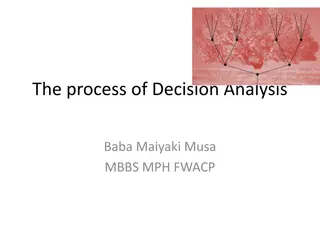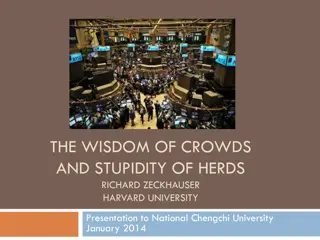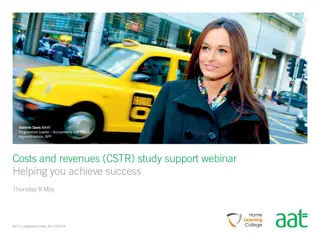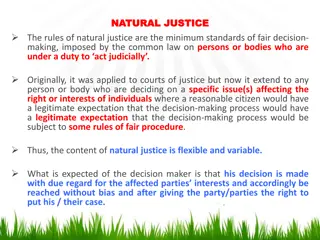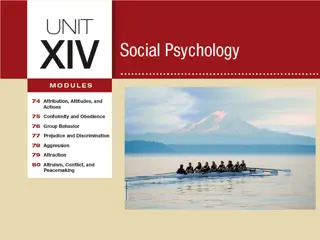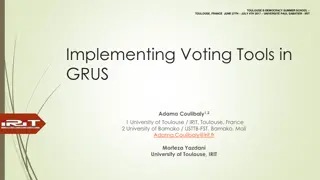Representativeness and Familiarity in Decision Making
The brain relies on mental shortcuts such as representativeness and familiarity to simplify information processing. Understand how representativeness bias can impact decision-making, as illustrated through examples like roulette and the gambler's fallacy. Explore the concept of extrapolation in financial decisions based on sentiment analysis. Dive into the implications of these cognitive biases in various scenarios, from investing to everyday choices.
Download Presentation

Please find below an Image/Link to download the presentation.
The content on the website is provided AS IS for your information and personal use only. It may not be sold, licensed, or shared on other websites without obtaining consent from the author.If you encounter any issues during the download, it is possible that the publisher has removed the file from their server.
You are allowed to download the files provided on this website for personal or commercial use, subject to the condition that they are used lawfully. All files are the property of their respective owners.
The content on the website is provided AS IS for your information and personal use only. It may not be sold, licensed, or shared on other websites without obtaining consent from the author.
E N D
Presentation Transcript
1 Chapter 8 Representativeness and Familiarity
Mental Shortcuts The brain uses mental shortcuts to reduce the complexity of analyzing information. These shortcuts allow the brain to generate an estimate of the answer before fully digesting all the available information. Examples are representativeness and familiarity.
Representativeness Bias The brain makes the assumption that things that share similar qualities are quite alike. A clean car must be a well-running car First example: past returns represent future returns Investors chase the hot mutual funds, the high stock price gainers, and a rising stock market
Roulette Anyone? Roulette is a casino game where a wheel and a ball are spun in opposite directions and eventually, the ball falls into a space. Bets can be placed on whether the ball will fall into a red, black, or green space. There are 18 red spaces, 18 black, and 1 green
Question: You re in Vegas and walk up to roulette tables with the 5 previous spins posted as: Table 1 2 27 31 26 12 Table 2 9 36 7 5 9 Which table would you feel more comfortable placing a bet on black ?
Representativeness Heuristic Representativeness Heuristic Belief that even small samples should be representative of the population People also think that the recent past is indicative of the future The Gambler s Fallacy says: 5 reds in a row in a fair game black is due! 6
Extrapolation Weekly and Monthly survey of members by the American Association of Individual Investors Bull/Bear, asset allocation Asset allocation changes over time Outcome: Sentiment about the stock market does lead to asset allocation changes No abnormal returns (poor market timing) Sentiment is backward-looking in returns Mary Bange, 2000, Do the Portfolios of Small Investors Reflect Positive Feedback Trading?, Journal of Financial & Quantitative Analysis, 35(2), 239-255. (Data: 1987-1994)
Judgment on Stereotypes The brain makes the assumption that things that share similar qualities are quite alike. Mary is quiet, studious, and concerned with social issues. While an undergraduate at Berkeley, she majored in English literature and environmental studies. Given this information, indicate which of the following three cases is most probable: A. Mary is a librarian. B. Mary is a librarian and a member of the Sierra Club. C. Mary works in the banking industry.
Judgment on Stereotypes The most common answer is B: Mary is a librarian and a member of the Sierra Club. People select this case because being a librarian and a member of the Sierra Club is representative Case A Mary is a librarian is a superior choice to B. Being a librarian and a Sierra Club member is a subset of being a librarian. Because case A includes case B, it is more probable The best choice is case C: Mary works in the banking industry. Many more people are employed by banks than by libraries; thus, it is more probable
Second Example (Representativeness bias) Investors confuse a good company with a good investment Good companies have strong earnings, growth, and good products, are good to work for, etc. Good investments increase in price more than alternatives But good companies are often overpriced and make poor investments!
Familiarity Another Mental Shortcut People prefer things that are familiar to them. In many cases, people believe the things they are familiar with are better than those things of which they are not familiar.
Familiarity Breeds Investment There are tens of thousands of stocks in the U.S. That many outside the U.S. as well. Which stocks do we pick? The ones with which we are familiar
Consider this Baby Bells Example In 1984, the government broke AT&T s local phone business into seven regional phone companies. Who owns these companies 12 years later? Started with diffuse ownership Now, investors are four times more likely to own the local utility company than any other utility company Gur Huberman, Familiarity Breeds Investment, Review of Financial Studies 14(2001): 659 680. John R. Nofsinger and Abhishek Varma, Individuals and Their Local Utility Stocks: Preference for the Familiar, Financial Review, 47 (2012): 423 443.
Familiarity Bias A typical money manager s portfolio consists of firms that are located 100 miles closer to the manager s office than the average US firm Joshua Coval and Tobias Moskowitz, Home Bias at Home: Local Equity Preference in Domestic Portfolios, Journal of Finance 54(1999): 2045 2073a
What Happens When You Move? What happens when an investor moves to another country? Do they maintain a home bias from their previous country? Obtain a home bias from the new country? Or overcome the home bias entirely? Studied the stock holdings of over 17,000 foreigners who move to Denmark Over time, foreigners increase their allocation to domestic stocks and after about 7 8 years, their home bias is similar to that of other Danes. Bjarne Florentsen, Ulf Nielsson, Peter Raahauge, and Jesper Rangvid, Turning Local: Home-bias Dynamics of Relocating Foreigners, Journal of Empirical Finance 58 (2020): 436-452
Local Bias 30% of investors stock portfolio is invested in firms located within 250 miles of their homes. United States Sweden Finland Finnish investors prefer local and same language firms (Finnish versus Swedish) When an investor moves to a different city, they re-balance their portfolio Firms furthest from the new city are most likely to be sold Stock purchases are tilted to new city local firms Andriy Bodnaruk, Proximity Always Matters: Local Bias When the Set of Local Companies Changes, Review of Finance, 2009, 13(4), 629-656.
Familiarity Breeds Home Bias Only half of worldwide stock equity is in the United States Portfolio theory suggests 30% to 50% of a portfolio should be in foreign securities (depending on risk level desired) The average international holdings is less than 5% Called the home bias Considered due to the familiarity problem
Familiarity Breeds Investment Data is from International Monetary Fund s Coordinated Portfolio Investment Survey for 2005.
When you do invest outside your country, where do you invest? Investors invest in countries that are familiar geography, language, religion Kalok Chan, Vicentiu Covrig, and Lilia Ng, What Determines the Domestic Bias and Foreign Bias? Evidence from Mutual Fund Equity Allocations Worldwide, Journal of Finance 60(2005): 1495 1534.
Familiaritys Market Impact The local bias of investors may distort stock prices in regions of the United States In some places there are few companies available for investors. These firms are the only game in town Price pressure from investors concentrating on few firms may drive those firms prices higher The price of a firm in the Deep South (relatively few firms) is 7.9 percent higher than a comparable firm in the middle Atlantic region (relatively many firms) The local bias of investors may skew the stock prices of smaller, less visible, regional firms the most Harrison Hong, Jeffrey Kubik, and Jeremy Stein, The Only Game in Town: Stock-Price Consequences of Local Bias, Journal of Financial Economics 90(2008): 20 37
Market Impact Internationally Countries with high domestic investor home bias also have risk premiums: Sie Ting Lau, Lilian Ng, and Bohui Zhang, The World Price of Home Bias, Journal of Financial Economics 97(2010): 191 217
Familiarity Breeds Investment Problems What companies are people most familiar with? Probably their employer A survey on Morningstar.com: Which is more likely to lose half of its value, your firm or the overall stock market? (1,000+ responded, only 16.4% stated their company) Continued
Familiarity Breeds Investment Problems Survey to Vanguard pension clients, 2003 Would you say your employer s stock is MORE RISKY, LESS RISKY, or has ABOUT THE SAME LEVEL OF RISK as an investment in a diversified stock fund with many different stocks? Employer s stock is Riskier: About the same risk: 39% Less risky: 33% 25% S. Benartzi, R. Thaler, S. Utkus, and C. Sunstein, 2007, The Law and Economics of Company Stock in 401(k) Plans, Journal of Law and Economics, 50(1): 45-79
Whats in a name? Familiarity? Companies with names that are easy to mentally process (fluency) experience higher levels investors and trading. Fluency: # Words Englishness Dictionary higher breadth of ownership improved liquidity higher firm values (B/M). Higher fluency leads to Change to a more fluent name is followed by these benefits Fluent mutual fund names receive high annual net inflows Fluent closed-end funds prices are relatively higher compared to NAV 25 Green and Jame, 2013, Company name fluency, investor recognition, and firm value, Journal of Financial Economics, 109: 813-834
401(k) Investments A survey of 242 SP500 companies found that 42% of the 401(k) assets were invested in the company stock! Danger! If your company files for bankruptcy, you are likely to lose your job and your 401(k) may be worthless. Employees are more likely to invest in their company s stock if the stock has performed well recently Familiarity and Representativeness
Summary Mental shortcuts, also called heuristic simplifications, help us analyze situation and make decisions quickly in our daily life. However, this process often leads us astray when analyzing decisions with risk and uncertainty. The representativeness bias causes us to extrapolate the past and assume that good companies are good investments.
Summary The familiarity bias causes us to believe that firms we are familiar with are better investments than unfamiliar firms. Thus, we own more local firms and our employer s stock and few international stocks. Thus, these biases lead to low diversification and higher risks.





